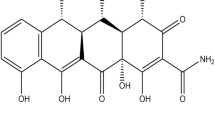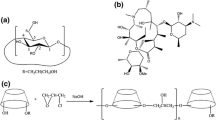Abstract
The aim of the present study was to prepare a stable complex of doxycycline (Doxy) and hydroxypropyl-β-cyclodextrin (HPβCD) for ophthalmic delivery and investigate the inclusion mechanism and the inclusion effects on the stability of Doxy. The Doxy/HPβCD complex was prepared by solution stirring and then characterized by scanning electron microscopy and ultraviolet spectroscopy. Based on results of nuclear magnetic resonance, molecular model of Doxy/HPβCD complex was established using computational simulation of PM3 method implemented in Gaussian 03. Stabilities of Doxy/HPβCD complex in both aqueous solution and solid state at 25°C were evaluated by HPLC. Finally, in vitro antibacterial activity of the Doxy/HPβCD complex was evaluated by disk diffusion test. It was found that the stabilities of Doxy/HPβCD complex in both aqueous solution and solid state were improved obviously as compared with Doxy alone. This stability enhancement is consistent with the inclusion mechanism between HPβCD and Doxy, which showed that the unstable site of Doxy molecule at 6-CH3 was protected in the hydrophobic cavity of HPβCD, additionally, the chelation of Mg2+ provided a synergetic protection of the other unstable site of Doxy at 4-N(CH3)2. The antibacterial activity results indicated that Doxy/HPβCD complex might have potential for clinical applications.







Similar content being viewed by others
REFERENCES
Ferreri AJ, Ponzoni M, Guidoboni M, Resti AG, Politi LS, Cortelazzo S, et al. Bacteria-eradicating therapy with doxycycline in ocular adnexal MALT lymphoma: a multicenter prospective trial. J Natl Cancer Inst. 2006;98(19):1375–82.
Smith VA, Cook SD. Doxycycline-a role in ocular surface repair. Br J Ophthalmol. 2004;88(5):619–25.
Libinson GS, Ushakova TA. Doxycycline. Stability in solutions. Pharm Chem J. 1976;10(8):1076–8.
Carrier RL, Miller LA, Ahmed M. The utility of cyclodextrins for enhancing oral bioavailability. J Control Release. 2007;123(2):78–99.
Loftsson T, Duchene D. Cyclodextrins and their pharmaceutical applications. Int J Pharm. 2007;329(1–2):1–11.
Brewster ME, Loftsson T. Cyclodextrins as pharmaceutical solubilizers. Adv Drug Deliv Rev. 2007;59(7):645–66.
Mady FM, Abou-Taleb AE, Khaled KA, Yamasaki K, Iohara D, Taguchi K, et al. Evaluation of carboxymethyl-beta-cyclodextrin with acid function: improvement of chemical stability, oral bioavailability and bitter taste of famotidine. Int J Pharm. 2010;397(1–2):1–8.
Stella VJ, Rao VM, Zannou EA, Zia V. Mechanisms of drug release from cyclodextrin complexes. Adv Drug Deliv Rev. 1999;36(1):3–16.
Cal K, Centkowska K. Use of cyclodextrins in topical formulations: practical aspects. Eur J Pharm Biopharm. 2008;68(3):467–78.
Armstrong WW, Neck M. Oxytetracycline compositions. US patent. 1976;646,295.
Nosworthy MM, Ferry G. Doxycycline parenteral compositions. US patent. 1976;477,703.
Su WR, Li ZR, Lin ML, Li YP, He ZX, Wu CB, et al. The effect of doxycycline temperature-sensitive hydrogel on inhibiting the corneal neovascularization induced by BFGF in rats. Graefes Arch Clin Exp Ophthalmol. 2011;249(3):421–7.
Cho HJ, Balakrishnan P, Shim WS, Chung SJ, Shim CK, Kim DD. Characterization and in vitro evaluation of freeze-dried microparticles composed of granisetron-cyclodextrin complex and carboxymethylcellulose for intranasal delivery. Int J Pharm. 2010;400(1–2):59–65.
Loftsson T, Brewster ME. Pharmaceutical applications of cyclodextrins. 1. Drug solubilization and stabilization. J Pharm Sci. 1996;85(10):1017–25.
de Paula WX, Denadai AML, Santoro MM, Braga ANG, Santos RAS, Sinisterra RD. Supramolecular interactions between losartan and hydroxypropyl-beta-CD: ESI mass-spectrometry, NMR techniques, phase solubility, isothermal titration calorimetry and anti-hypertensive studies. Int J Pharm. 2011;404(1–2):116–23.
Mura P, Bettinetti G, Melani F, Manderioli A. Interaction between naproxen and chemically modified [beta]-cyclodextrins in the liquid and solid state. Eur J Pharm Sci. 1995;3(6):347–55.
Yap KL, Liu X, Thenmozhiyal JC, Ho PC. Characterization of the 13-cis-retinoic acid/cyclodextrin inclusion complexes by phase solubility, photostability, physicochemical and computational analysis. Eur J Pharm Sci. 2005;25(1):49–56.
Xing SK, Zhang C, Ai HQ, Zhao Q, Zhang Q, Sun DZ. Theoretical study of the interactions of beta-cyclodextrin with 2 ′-hydroxyl-5 ′-methoxyacetophone and two of its isomers. J Mol Liq. 2009;146(1–2):15–22.
Shi JH, Ding ZJ, Hu Y. Theoretical study on chiral recognition mechanism of methyl mandelate enantiomers on permethylated beta-cyclodextrin. J Mol Model. 2012;18(2):803–13.
Chen MW, Pan X, Wu HM, Han K, Xie XB, Wedge DE, et al. Preparation and anti-bacterial properties of a temperature-sensitive gel containing silver nanoparticles. Pharmazie. 2011;66(4):272–7.
Rios JL, Recio MC, Villar A. Screening methods for natural products with antimicrobial activity: a review of the literature. J Ethnopharmacol. 1988;23(2–3):127–49.
He ZX, Wang ZH, Zhang HH, Pan X, Su WR, Liang D, et al. Doxycycline and hydroxypropyl-β-cyclodextrin complex in poloxamer thermal sensitive hydrogel for ophthalmic delivery. Acta Pharmacol Sin B. 2011;1(4):254–60.
Gibaud S, Ben ZS, Mutzenhardt P, Fries I, Astier A. Melarsoprol-cyclodextrins inclusion complexes. Int J Pharm. 2005;306(1–2):107–21.
Zhao M, Wang H, Yang B, Tao H. Identification of cyclodextrin inclusion complex of chlorogenic acid and its antimicrobial activity. Food Chem. 2010;120(4):1138–42.
Yang B, Lin J, Chen Y, Liu Y. Artemether/hydroxypropyl-beta-cyclodextrin host-guest system: characterization, phase-solubility and inclusion mode. Bioorg Med Chem. 2009;17(17):6311–7.
Torri G, Bertini S, Giavana T, Guerrini M, Puppini N, Zoppetti G. Inclusion complex characterization between progesterone and hydroxypropyl-beta-cyclodextrin in aqueous solution by NMR study. J Incl Phenom Macrocycl Chem. 2007;57(1–4):317–21.
Jullian C, Cifuentes C, Alfaro M, Miranda S, Barriga G, Olea-Azar C. Spectroscopic characterization of the inclusion complexes of luteolin with native and derivatized beta-cyclodextrin. Bioorg Med Chem. 2010;18(14):5025–31.
Li JS, Xiao HN, Li JH, Zhong YP. Drug carrier systems based on water-soluble cationic beta-cyclodextrin polymers. Int J Pharm. 2004;278(2):329–42.
Rojas-Aguirre Y, Yepez-Mulia L, Castillo I, Lopez-Vallejo F, Soria-Arteche O, Hernandez-Campos A, et al. Studies on 6-chloro-5-(1-naphthyloxy)-2-(trifluoromethyl)-1H-benzimidazole/2-hydroxypropyl-beta-cyclodextrin association: characterization, molecular modeling studies, and in vivo anthelminthic activity. Bioorg Med Chem. 2011;19(2):789–97.
Kollman PA, Massova I, Reyes C, Kuhn B, Huo S, Chong L, et al. Calculating structures and free energies of complex molecules: combining molecular mechanics and continuum models. Acc Chem Res. 2000;33(12):889–97.
Jullian C, Orosteguis T, Perez-Cruz F, Sanchez P, Mendizabal F, Olea-Azar C. Complexation of morin with three kinds of cyclodextrin. A thermodynamic and reactivity study. Spectrochim Acta A Mol Biomol Spectrosc. 2008;71(1):269–75.
Szejtli J. Introduction and general overview of cyclodextrin chemistry. Chem Rev. 1998;98(5):1743–54.
Skulason S, Ingolfsson E, Kristmundsdottir T. Development of a simple HPLC method for separation of doxycycline and its degradation products. J Pharm Biomed Anal. 2003;33(4):667–72.
Newman EC, Frank CW. Circular dichroism spectra of tetracycline complexes with Mg+2 and Ca+2. J Pharm Sci. 1976;65(12):1728–32.
Lambs L, Venturim M, Révérend BDL, Kozlowski H, Berthon G. Metal ion-tetracycline interactions in biological fluids: part 8. Potentiometric and spectroscopic studies on the formation of Ca (II) and Mg (II) complexes with 4-dedimethylamino-tetracycline and 6-desoxy-6-dem. J Inorg Biochem. 1988;33(3):193–209.
Silva PP, Guerra W, Silveira JN, Ferreira AMC, Bortolotto T, Fischer FL, et al. Two new ternary complexes of copper(II) with tetracycline or doxycycline and 1,10-phenanthroline and their potential as antitumoral: cytotoxicity and DNA cleavage. Inorg Chem. 2011;50(14):6414–24.
Author information
Authors and Affiliations
Corresponding author
Rights and permissions
About this article
Cite this article
Zhang, H., Chen, M., He, Z. et al. Molecular Modeling-Based Inclusion Mechanism and Stability Studies of Doxycycline and Hydroxypropyl-β-Cyclodextrin Complex for Ophthalmic Delivery. AAPS PharmSciTech 14, 10–18 (2013). https://doi.org/10.1208/s12249-012-9877-1
Received:
Accepted:
Published:
Issue Date:
DOI: https://doi.org/10.1208/s12249-012-9877-1




